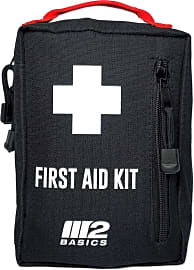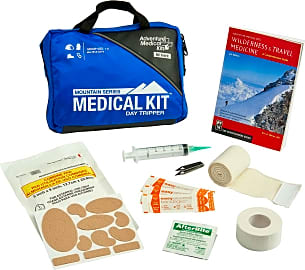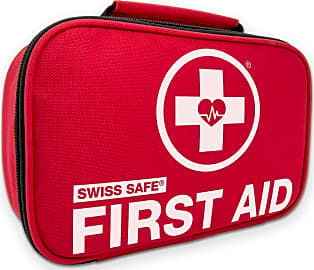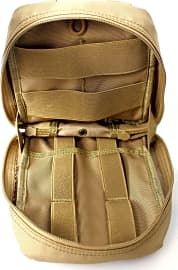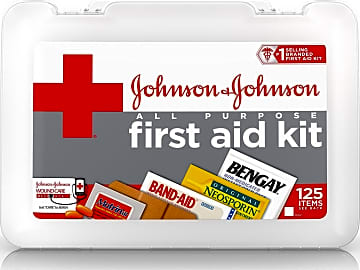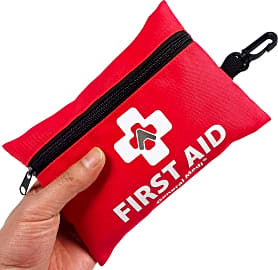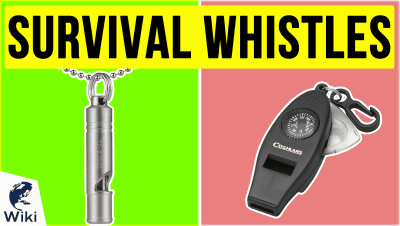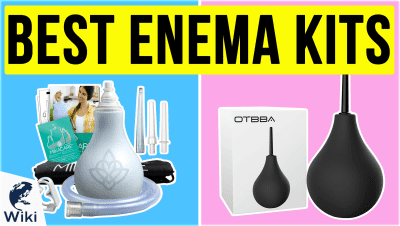The 10 Best First Aid Kits

This wiki has been updated 41 times since it was first published in May of 2015. From basic treatments for cuts and scrapes to full-scale casualty supplies, these first aid kits will help ensure you’re prepared for accidents or emergencies at home, on the road, or in the workplace. They’re also extremely useful for camping trips or remote fishing and hiking excursions when access to medical care is limited. Many come with convenient, portable travel cases. When users buy our independently chosen editorial choices, we may earn commissions to help fund the Wiki.
Editor's Notes
March 30, 2020:
We eliminated the Aootek Travel and Anmeilu Mini, both of which were no longer available. We also learned that the description of the First Aid Only All-Purpose was deceptive, advertising contents that are not included with the kit. We removed this item as well.
We noted that the DeftGet Essential includes most of what you’d expect in a standard first aid kit, but some unusual add-ons — particularly the mini flashlight — make this model a hit with many users, who also appreciate the waterproof case.
Two of our new additions, the Carlebben EMT Pouch and M2 Basics Survival, are Molle-compatible, which is useful for attaching them to backpacks or vests as part of an outdoor excursion. The Protect Life Home is a well-rounded choice: it’s portable, stocked with 200 pieces, and includes less-common items like a cold pack, a raincoat and a whistle.
Special Honors
ProPac FAC-5 Deluxe If you need to equip a business, school, or some other facility with a healthy inventory of first aid gear, this five-shelf cabinet is a good place to start. It’s stocked with hundreds of bandages, medications, dressings, medical tools, and various sprays, gels and creams. propacusa.com
Stealth Angel Kits Stealth Angel should have something to fit your needs, whether that’s a wall-mounted shelf to serve dozens of people or a portable case that can be attached to a vest during a hiking or camping trip. For the amount of storage space they provide, the cabinets are a nice value. stealthangelsurvival.com
SOS Campus Fannypack Whether they’re a fashion faux-pas is a fair debate, but few can argue with the functionality of a fanny pack. Those who prefer to keep their hands free and their backpacks light may prefer this small kit, which comes with a variety of first aid essentials. sosproducts.com
The All-Important First Aid Kit
Also make sure to have working flashlights with spare batteries and clothing/bedding appropriate for the season and region.
Daily life often brings its share of minor scrapes, burns, puncture wounds, or bug bites. We take most of these small injuries for granted and tend to them as needed, cleaning cuts or scuffs with antiseptic and/or alcohol wipes, managing insect stings with anti-itch ointments, and dressing the afflicted areas with a bandage or with some gauze and medical tape.
That is, we respond in stride if we have access to a decent first aid kit. The fact is that far too many homes, offices, and even some schools and daycare centers are without proper first aid supplies. According to a national survey conducted in recent years, nearly half of the households in America do not have a first aid kit. Having a spot in the pantry where your family keeps a few bandages and a bottle of hydrogen peroxide does not constitute genuine first aid preparedness; only the purchase of a purpose-built kit (or the painstaking assembly of your own kit) represents responsible preparation for the many medical issues you and those around you might face.
When deciding which first aid kit best suits your needs, it's a good idea to first consider those for whom its contents might one day be used. First simply consider the number of people in the home, office, or other location for which you are making the purchase. Many kits clearly specify the intended number of individuals for which they were assembled (50-person and 100-person kits are common, for example).
For the average household, any basic kit should suffice; if your home has special concerns, such as heightened likeliness of insect bites due to the climate or frequent injuries due to the nature of energetic small children, consider a larger, more comprehensive kit. Choosing a fitting first aid kit for a larger group of people is a more challenging affair, for with a large group necessarily comes more diverse needs.
When buying a kit intended to service an office or school, look for one that includes more than mere antiseptics, bandages, and the like; instead look for an option that also has basic medicines suitable for treating minor pains and indigestion issues. While most homes have this type of medicine on hand even if the household does not have an actual first aid kit, most businesses will not have such supplies available, thus it should be included with the wound cleaning and dressing supplies.
Also consider making your first aid kit but one part of greater emergency/disaster response gear. It's a wise idea to keep enough food and fresh water on hand to sustain those in a household for at least three to four days. Also make sure to have working flashlights with spare batteries and clothing/bedding appropriate for the season and region.
Basic First Aid Wound Care
It's a good idea to plan ahead for how you will treat the cuts and scrapes that most often merit care using a first aid kit. Assuming you yourself are uninjured and are caring for another person's injury, these are the basic steps to follow -- mind that you always immediately call for emergency response in the event of any serious injury that you are not fully confident you can manage without assistance.
If there is visible debris present in or near the injury, attempt to flush it again and/or remove the debris using sterilized tweezers.
Assuming a person's wound is not causing heavy loss of blood, the first step you should take is always to wash your hands. If no soap and water are available, use the antiseptic towelettes likely contained in your first aid kit.
Next it is time to stop the wound from bleeding. If possible, as with a cut to a hand, arm, foot, or leg, elevate the injury above the victim's heart to reduce the blood flow. Apply gentle pressure to the wound using a sterile pad from the first aid set.
Once the bleeding has stopped, you must clean the wound itself and the area immediately around it. Wipe the nearby skin clean, flush the cut or burn with water, and then clean and sterilize it. Do this with alcohol and/or antiseptic products found in the first aid kit, and when possible do not use soap, as it can be an irritant. If there is visible debris present in or near the injury, attempt to flush it again and/or remove the debris using sterilized tweezers.
After the injury has been cleaned and then allowed to dry, apply a thin layer of an antibiotic ointment to prevent the likelihood of infection. Now gently dress the wound, using the minimum amount of bandaging necessary to cover and protect the afflicted area. Airflow is good for minor injuries, while deeper and more serious scrapes, burns, or gouges may need to be fully covered for the initial few days of healing.
Other Medical/Emergency Items To Have On Hand
As made clear, keeping a first aid kit in the home, vehicle, and/or office should not be considered intelligent, it should be considered imperative. But while a basic first aid package can help mitigate many medical issues, it is nonetheless a baseline from which to start your response to an injury or emergency; there is plenty of additional gear that can help you help yourself, your coworkers, or your friends and family members.
And finally, simply make sure to have important information -- such as contact numbers for family members and any medical specialists you see -- in hard copy.
Even a great first aid kit will not transform you (or anyone else) into a trained medical professional, so being able to safely contact paramedics is a good idea, especially if your home is without a landline. While cellular phones are generally reliable, in the event that yours cannot complete a call, an emergency radio can provide a backup way to reach a first responder. And if you do plan to rely on your cellular phone for assistance in times of emergency, at least be sure to have a backup power source on hand, as the electrical grid will quickly fail in the path of major weather events or in times of severe civil unrest.
As mentioned earlier, a supply of food that can last for several days is always wise; fresh water is even more critical. Also be sure to have several days worth of medicine that anyone in your home requires, as ready access to re-supply can at times be confounded.
And finally, simply make sure to have important information -- such as contact numbers for family members and any medical specialists you see -- in hard copy. Should your computer or phone run out of power, be lost, or be damaged, it's important that you can still get access to critical information.


